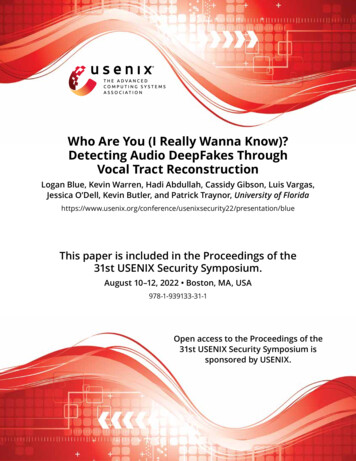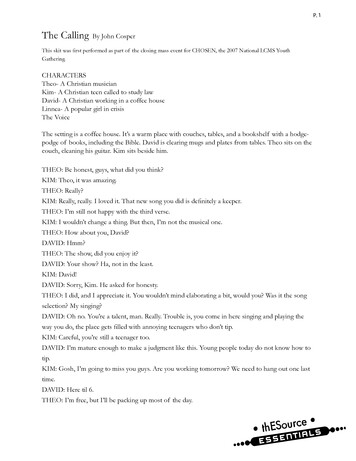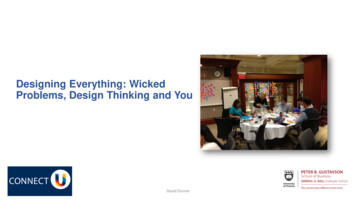
Transcription
Who Are You (I Really Wanna Know)?Detecting Audio DeepFakes ThroughVocal Tract ReconstructionLogan Blue, Kevin Warren, Hadi Abdullah, Cassidy Gibson, Luis Vargas,Jessica O’Dell, Kevin Butler, and Patrick Traynor, University of urity22/presentation/blueThis paper is included in the Proceedings of the31st USENIX Security Symposium.August 10–12, 2022 Boston, MA, USA978-1-939133-31-1Open access to the Proceedings of the31st USENIX Security Symposium issponsored by USENIX.
Who Are You (I Really Wanna Know)? Detecting Audio DeepFakes Through VocalTract ReconstructionLogan Blue, Kevin Warren, Hadi Abdullah, Cassidy Gibson, Luis Vargas, Jessica O’Dell, Kevin Butler,Patrick TraynorUniversity of Florida, Gainesville, FLEmail: {bluel, kwarren9413, hadi10102, c.gibson, lfvargas14, odelljessica, butler,traynor}@ufl.eduAbstractGenerative machine learning models have made convincingvoice synthesis a reality. While such tools can be extremelyuseful in applications where people consent to their voicesbeing cloned (e.g., patients losing the ability to speak, actors not wanting to have to redo dialog, etc), they also allowfor the creation of nonconsensual content known as deepfakes. This malicious audio is problematic not only becauseit can convincingly be used to impersonate arbitrary users,but because detecting deepfakes is challenging and generallyrequires knowledge of the specific deepfake generator. Inthis paper, we develop a new mechanism for detecting audiodeepfakes using techniques from the field of articulatory phonetics. Specifically, we apply fluid dynamics to estimate the arrangement of the human vocal tract during speech generationand show that deepfakes often model impossible or highlyunlikely anatomical arrangements. When parameterized toachieve 99.9% precision, our detection mechanism achievesa recall of 99.5%, correctly identifying all but one deepfakesample in our dataset. We then discuss the limitations of thisapproach, and how deepfake models fail to reproduce all aspects of speech equally. In so doing, we demonstrate thatsubtle, but biologically constrained aspects of how humansgenerate speech are not captured by current models, and cantherefore act as a powerful tool to detect audio deepfakes.1IntroductionThe ability to generate synthetic human voices has long been adream of scientists and engineers. Over the past 50 years, techniques have included comprehensive dictionaries of spokenwords and formant synthesis models that create new soundsthrough the combination of frequencies. While such techniques have made important progress, their outputs are generally considered robotic-sounding and easily distinguishablefrom organic speech. Recent advances in generative machinelearning models have led to dramatic improvements in synthetic speech quality, with convincing voice reconstructionUSENIX Associationnow available to groups including patients suffering from theloss of speech due to medical conditions and grieving familymembers of the recently deceased [1, 2].While these speech models are a powerful and importantenabler of communication, they also create significant problems for users who have not given their consent. Specifically,generative machine learning models now make it possible tocreate audio deepfakes, which allow an adversary to simulate a targeted individual speaking arbitrary phrases. Whilepublic individuals have long been impersonated, such toolsmake impersonation scalable, putting the general populationat risk. Such attacks have reportedly been observed in thewild, including a company that allowed an attacker to instructfunds to be sent to them using generated audio of the victimcompany’s CEO’s voice [3]. In response, researchers havedeveloped detection techniques using bispectral analysis (i.e.,inconsistencies in the higher-order correlations in audio) [4,5]and training machine learning models as discriminators [6];however, both are highly dependent on the specific, previouslyobserved generation techniques to be effective.In this paper, we develop techniques to detect deepfake audio samples by solely relying on limitations of human speechthat are the results of biological constraints. Specifically, weleverage research in articulatory phonetics to apply fluid dynamic models that estimate the arrangement of the humanvocal tract during speech. Our analysis shows that deepfakeaudio samples are not fundamentally constrained in this fashion, resulting in vocal tract arrangements that are inconsistentwith human anatomy. Our work demonstrates that this inconsistency is a reliable detector for deepfake audio samples.We make the following contributions: Identify inconsistent vocal tract behavior: Using acombination of fluid dynamics and articulatory phonetics, we identify the inconsistent behavior exhibited bydeepfaked audio samples (e.g., unnatural vocal tract diameters). We develop a technique to estimate the vocaltract during speech to prove this phenomenon. Constructing a deepfake detector: After proving theexistence of the phenomena, we construct a deepfake31st USENIX Security Symposium2691
detector that is capable of detecting deepfake audio(Precision: 99.9%, Recall: 99.5%) from a large datasetwe create using the Real-Time Voice Cloning generator [7]. Finally, we also demonstrate that entries from theASVSpoof2019 dataset are easily detectable in the prefiltering portion of our mechanism due to a high worderror rate in automatic transcription. Analysis of deepfake detector: We further analyzewhich vocal tract features and portions of speech causethe deepfakes to be detectable. From this analysis, wedetermine that on average our detector only requires asingle sentence to detect a deepfake with a true positiverate (TPR) of 92.4%. Analysis of Potential Adaptive Adversaries: We conducted two large-scale experiments emulating both anaïve and an advanced adaptive adversary. Our experiments consist of training 28 different models and showthat in the best case, an adaptive adversary faces greaterthan a 26x increase in training time, increasing the approximate time necessary to train the model to over 130days.We note that the lack of anatomical constraints is consistent across all deepfake techniques. Without modeling theanatomy or forcing the model to operate within these constraints, the likelihood that a model will learn a biologicallyappropriate representation of speech is near zero. Our detector,therefore, drastically reduces the number of possible modelsthat can practically evade detection.The paper is organized as follows: Section 2 provides context by discussing related work; Section 3 gives backgroundon relative topics used throughout this paper; Section 4 discusses our underlying hypothesis; Section 5 details our threatmodel; Section 6 explains our methodology and detectionmethod; Section 7 describes our data collection and experimental design; Section 8 discusses the results of our experiments; Section 9 details the intricacies and consequences ofour work; and Section 10 provides concluding remarks.2Related WorkAdvances in Generative Adversarial Networks (GANs) haveenabled the generation of synthetic “human-like” audio that isvirtually indistinguishable from audio produced by a humanspeaker. In some cases, the high quality of GAN-generatedaudio has made it difficult to ascertain whether the audio heard(e.g., over a phone call) was organic [8]. This has enabledpersonalized services such as Google Assistant [9], AmazonAlexa [10], and Siri [11], which use GAN-generated audioto communicate with users. GANs can also be trained toimpersonate a specific person’s audio, this kind of audio isknown as a deepfake [12].The dangerous applications of deepfake audio have spurredthe need to automatically identify human audio samples from269231st USENIX Security Symposiumdeepfakes. Some of the current work in this area has focusedon identifying subtle spectral differences that are otherwiseimperceptible to the human ear [4,5]. In some cases, the deepfake audio will be played over a mechanical speaker, whichwill itself leak artifacts into the audio sample. These artifactscan be detected using a variety of techniques such as machinelearning models [13, 14], additional hardware sensors [15],or spectral decomposition [16]. Researchers have also triedto detect these artifacts by using mobile devices. They usedifferences in the time-of-arrival in phoneme sequences, effectively turning the mobile devices into a Doppler Radar thatcould verify the audio source [17, 18]. These techniques fallwithin the category of liveness detection and have spawnedmajor competitions such as the ASV Spoof Challenge [19].However, these methods have certain limitations including thedistance of the speaker from the recording microphone, accuracy, additional hardware requirements, and large training sets.Phonetics (the scientific study of speech sounds) is commonlyused by language models for machine learning systems builtfor speech to text [20, 21] or speaker recognition [22]. Speechrecognition and audio detection tools also use phonetics toincrease their overall performance and capabilities [23, 24].While articulatory phonetics is not commonly used in security, this has been used in past work, such as reconstructingencrypted VoIP calls by identifying phonemes [25].Using concepts of articulatory phonetics, our work attemptsto extract the physical characteristics of a speaker from agiven audio sample; these characteristics would otherwise notbe present in deepfake audio. Human or organic speech iscreated using a framework of muscles and ligaments aroundthe vocal tract. The unique sound of each of our voices isdirectly tied to our anatomy [26]. This has enabled researchersto use voice samples of a speaker to extract the dimensionsof their anatomical structures such as vocal tract length [27–31], age [32], or height [33, 34] of the speaker. These worksattempt to derive an acoustical pipe configuration by modelingthe human pharynx. This configuration can then be usedas a proxy for the human anatomy to retrieve the physicalcharacteristics of the speaker. Since deepfakes are generatedusing GANs, the physical dimensions are likely inconsistent.This inconsistency can be measured and help differentiatebetween deepfake and human audio samples.33.1BackgroundPhonemesPhonemes are the fundamental building blocks of speech.Each unique phoneme sound is a result of different configurations of the vocal tract components shown in Figure 1.Phonemes that comprise the English language are categorizedinto vowels, fricatives, stops, affricates, nasals, glides, anddiphthongs (Table 1).Vowels (e.g., “/I/” in ship) are created using different ar-USENIX Association
PalatePhoneme ngOral CavityAlveolar niceliewaitTable 1: English is composed of these seven categories ofphonemes. Their pronunciation is dependent on the configuration of the various vocal tract components and the airflowthat goes through it.spectrogramFigure 1: The vocal tract is composed of various componentsthat act together to produce sounds. Distinct phonemes are articulated based on the path the air travels, which is determinedby how the components are cat)rangements of the tongue and jaw, which result in resonancechambers within the vocal tract. For a given vowel, thesechambers produce frequencies known as formants whose relationship determines the actual sound. Vowels are the mostcommonly used phoneme type in the English language, making up approximately 38% of all phonemes [35]. Fricatives(e.g.,“/s/” in sun) are generated by turbulent flow caused by aconstriction in the airway, while stops (e.g.,“/g/” in gate) arecreated by briefly halting and then quickly releasing the airflow in the vocal tract. Affricatives (e.g.,“/tS/” in church) area concatenation of a fricative with a stop. Nasals (e.g.,“/n/”in nice) are created by forcing air through the nasal cavityand tend to be at a lower amplitude than the other phonemes.Glides (e.g.,“/l/” in lie) act as a transition between differentphonemes, and diphthongs (e.g.,“/eI/” in wait) refer to thevowel sound that comes from the lips and tongue transitioningbetween two different vowel positions.Phonemes alone do not encapsulate how humans speak.The transitions between two phonemes are also important forspeech since it is a continuous process. Breaking speech downinto pairs of phonemes (i.e., bigrams) preserves the individualinformation of each phoneme as well as transitions betweenthem. These bigrams generate a more accurate depiction ofthe vocal tract dynamics during the speech process.3.2Organic SpeechHuman speech production results from the interactions between different anatomical components, such as the lungs,larynx (i.e., the vocal cords), and the articulators (e.g., thetongue, cheeks, lips), that work in conjunction to producesound. The production of sound1 starts with the lungs forc1 Thisprocess is similar to how trumpets create a sound as air flowsthrough various pipe configurations.USENIX AssociationwaveformEncoderVocoder(dog)Figure 2: Deepfake generation has several stages to createa fake audio sample. The encoder generates an embeddingof the speaker, the synthesizer creates a spectrogram for atargeted phrase using the speaker embedding, and the vocoderconverts the spectrogram into the synthetic waveform.ing air through the vocal cords, which induces an acousticresonance that contains the fundamental (lowest) frequencyof a speaker’s voice. The resonating air then moves throughthe vocal cords and into the vocal tract (Figure 1). At thispoint, different configurations of the articulators (e.g., wherethe tongue is placed, how large the mouth is) shape the pathfor the air to flow, which creates constructive/destructive interference that produces the unique sounds of each phoneme.3.3Deepfake AudioDeepfakes are digitally produced speech samples that areintended to sound like a specific individual. Currently, deepfakes are produced via the use of machine learning (ML)algorithms. While there are numerous deepfake ML algorithms in existence, the overall framework the techniques arebuilt on are similar. As shown in Figure 2, the framework iscomprised of three stages: encoder, synthesizer, and vocoder.Encoder: The encoder learns the unique representation ofthe speaker’s voice, known as the speaker embedding. Thesecan be learned using a model architecture similar to that ofspeaker verification systems [36]. The embedding is derivedfrom a short utterance using the target speaker’s voice. Theaccuracy of the embedding can be increased by giving theencoder more utterances, with diminishing returns. The outputembedding from the encoder stage is passed as an input intothe following synthesizer stage.Synthesizer: A synthesizer generates a Mel Spectrogram31st USENIX Security Symposium2693
from a given text and the speaker embedding. A Mel Spectrogram is a spectrogram that has its frequencies scaled usingthe Mel scale, which is designed to model audio perception ofthe human ear. Some synthesizers can produce spectrogramssolely from a sequence of characters or phonemes [37].Vocoder: Lastly, the vocoder converts the Mel Spectrogramto retrieve the corresponding audio waveform. This newlygenerated audio waveform will ideally sound like a targetindividual uttering a specific sentence. A commonly usedvocoder model is some variation of WaveNet [38], which usesa deep convolutional neural network that uses surroundingcontextual information to generate its waveform.Although the landscape of audio generation tools is everchanging, these three stages are the foundational componentsof the generation pipeline. The uniqueness of each tool isderived mainly from the quality of models (one for each stage)and the exact design of their system architecture.4HypothesisHuman-created speech is fundamentally bound to the anatomical structures that are used to generate it. Only certain arrangements of the vocal tract are physically possible for aspeaker to create. The number of possible acoustic modelsthat can accurately reflect both the anatomy and the acoustic waveform of a speaker is therefore limited. Alternatively,synthetic audio is not restricted by any physical structuresduring its generation. Therefore, an infinite set of acousticmodels could have generated the synthetic audio. The detailsof this phenomenon will be discussed shortly in Section 6. Itis highly improbable that models used to generate syntheticaudio will mimic an acoustic model that is consistent withthat of an organic speaker. As such, synthetic audio can bedetected by modeling the acoustic behavior of a speaker’svocal tract.5Security ModelOur security model consists of an adversary, a victim, and adefender. The goal of the adversary is to create a deepfakeaudio sample of the victim uttering a specific phrase. Weassume a powerful adversary, one who has access to enoughof the victim’s audio and enough computing power to generatea deepfake sample.The adversary offers the defender either the deepfake oran organic audio sample. The defender is tasked with ascertaining whether the adversary-provided sample is deepfake ororganic audio. If the defender makes the correct assessment,the adversary loses.The defender does not have knowledge of, or audio datafrom, the victim the adversary will attempt to impersonate(i.e., no user-specific audio samples of the victim). The defender also has no knowledge of, or access to, the attacker’s269431st USENIX Security Symposiumaudio generation algorithm. This is a stronger threat modelthan existing works in the area, which often use very largetraining data sets (order of thousands of audio samples) [6].Lastly, we assume that the defender wants an explanationas to why their detection system flagged a sample as eitherdeepfake or organic.A practical example of this scenario is as follows. An adversary creates a deepfake of a local politician and releases it tothe media to further some goal. The media is the defender inthis scenario and must decide whether the adversary’s audiosample is authentic. Once the authenticity of the audio sample has been checked the media can choose to either ignoreor publish the audio. If the media publishes a syntheticallygenerated audio sample, then the adversary has successfullyvictimized the politician by making them appear to have saidsomething they did not. Additionally, any media outlet whichpublishes a synthetic audio sample could have its reputationdamaged if it is later discovered that the audio sample wasinauthentic. By leveraging our technique, the media outlet canprevent reporting inauthentic audio samples, thus preventingtheir loss of reputation and the victimization of the politician.6MethodologyOur technique requires a training set of organic audio and asmall set of deepfake audio samples generated by the deepfakealgorithm.2 The process of determining the source of an audiosample (i.e., organic vs deepfake) can then be broken downinto two logical steps: Vocal Tract Feature Estimator: First, we construct amathematical model of the speaker’s vocal tract basedon the amplitudes of certain frequencies (commonlyreferred to as the frequency response) present in theirvoice during a specific pair of adjacent phonemes (i.e.,bigram). This model allows us to estimate the crosssectional area of the vocal tract at various points alongthe speaker’s airway. Deepfake Audio Detector: Next, we aggregate therange of values found for each bigram-feature pair in ourorganic dataset. These values determine if the audio sample can be realistically produced by an organic speaker.This enables our system to discriminate between organicand deepfake samples. Additionally, we can isolate thebigram-feature pairs that best determine the source ofan audio sample to create a set of ideal discriminators.These ideal discriminators allow us to optimally determine whether an unseen audio sample is a deepfake.2 The training data is a general set that does not require samples of thespecific victim that is being targeted. Additionally, the training data requiredfor this technique is significantly less than the data required with prior MLbased techniques.USENIX Association
Cross Sectional AreaABCVocal Tract PositionCBACross Sectional AreaBAABCCVocal Tract PositionWho/hu/Has/hæz/Figure 3: The sound produced by a phoneme is highly dependent on the structure of the vocal tract. Constriction made by tonguemovement or jaw angle filters different frequencies.6.1Reader ParticipationBefore we go further into the details of these two steps, wewould like to help the reader develops a deeper intuition ofphonemes and speech generation.For speech, air must move from the lungs to the mouthwhile passing through various components of the vocal tract.To understand the intuition behind our technique, we invitethe reader to speak out loud the words “who” (phoneticallyspelled “/hu/”) and “has” (phonetically spelled “/hæz/”) whilepaying close attention to how the mouth is positioned duringthe pronunciation of each vowel phoneme (i.e., “/u/” in “who”and “/æ/” in “has”).Figure 3 shows how the components are arranged duringthe pronunciation of the vowel phonemes for each word mentioned above. Notice that during the pronunciation of thephoneme “/u/” in “who” the tongue compresses to the backof the mouth (i.e., away from the teeth) (A) at the same time,the lower jaw is held predominately closed. The closed jawposition lifts the tongue so that it is closer to the roof of themouth (B). Both of these movements create a specific pathway through which the air must flow as it leaves the mouth.Conversely, the vowel phoneme “/æ/” in “has” elongates thetongue into a more forward position (A) while the lower jawdistends, causing there to be more space between the tongueand the roof of the mouth. This tongue position results in adifferent path for the air to flow through, and thus creates adifferent sound. In addition to tongue and jaw movements, theposition of the lips also differs for both phonemes. For “/u/”,the lips round to create a smaller more circular opening (C).Alternatively, “/æ/” has the lips unrounded, leaving a larger,more elliptical opening. Just as the tongue and jaw position,the shape of the lips also impacts the sound created.One additional component that affects the sounds of aphoneme is the other phonemes that are adjacent to it. Forexample, take the words “ball” (phonetically spelled “/bOl/”‘)and “thought” (phonetically spelled “/TOt/”). Both words contain the phoneme “/O/,” however the “/O/” in “thought” isUSENIX Associationaffected by the adjacent phonemes differently than how “/O/”in “ball” is. In particular “thought” ends with the plosive “/t/”which requires a break in airflow, thus causing the speaker toabruptly end the “/O/” phoneme. In contrast, the “/O/” in “ball”is followed by the lateral approximant “/l/,” which does notrequire a break-in airflow, leading the speaker to graduallytransition between the two phonemes.6.2Vocal Tract Feature EstimatorBased on the intuition built in the previous subsection, ourmodeling technique needs to be able to extract the shape ofthe vocal tract present during the articulation of a specificbigram. To do this, we use a fluid dynamic concatenated tubemodel to estimate the speaker’s vocal tract that is similar toRabiner et al.’s technique [27]. Before we go into the detailsof this model, it is important to discuss the assumption themodel makes. Lossless Model: Our model ignores energy losses thatresult from the fluid viscosity (i.e., the friction lossesbetween molecules of the air), the elastic nature of thevocal tract (i.e., the cross-sectional area changing dueto a change in internal pressure), and friction betweenthe fluid and the walls of the vocal tract. Ignoring theseenergy losses will result in our model having acousticdampening, causing the lower formant frequencies to increase in value3 and an increase in the bandwidth of allformant frequency spikes4 . Additionally, we assume thewalls of the vocal tract have an infinitely high acousticimpedance (i.e., sound can only exit the speaker fromtheir mouth) which will result in our model missing traceamounts of low bass frequencies. Overall, these assumptions simplify the modeling processing while decreasingthe accuracy of our technique by a marginal amount andare consistent with prior work [27].3 Thiseffect is mainly caused by the elastic nature of the vocal tract walls.viscosity and friction losses predominately effect frequencies above4 kHz [27].4 The31st USENIX Security Symposium2695
uoA2A3A5A41uoA6A1uo1L11L4L2L5 - L6u1Negative flowu1u1(1 rk)-rk1Positive flow - rkL3uo-Figure 4: The cross sectional area of each pipe is calculatedto characterize the speaker’s voice tract. Unidirectional Traveling Waves: We assume that,within the model, we will only have traveling wavesalong the centerline of the tube. It stands to reason thatthis assumption is accurate enough for our model giventhe small diameter of our tubes (i.e., vocal tract). Thisassumption should not affect our results since any errorcaused by this assumption will most likely occur in frequencies greater than 20 kHz (far above human speech).As we will discuss later in this section, our model is mostaccurate for lower frequencies and thus we only analyzefrequencies beneath 5 kHz.5 Vowel Limitation: The model used in this paper wasonly designed to accurately model vowel phonemes.Other phonemes are generated via fundamentally different and more difficult model mechanisms such asturbulent flow. Despite this, we apply the same modelacross all bigrams throughout this work for reasons discussed in Section 9.1.Our concatenated tube model consists of a series of openpipe resonators that vary in diameters but share the samelength. A simplified representation can be seen in Figure 4.To estimate the acoustics of an individual tube at a specifictime during a bigram, we need to understand the behaviorof pressure waves within the resonator. The simplest way todo this is to model the net volumetric flow rate of the fluid(i.e., the air in the vocal tract) within the resonator. We canmodel the acoustics of a resonator via the flow rate since thevolumetric flow rate and the pressure (i.e., sound) within theresonator are directly related [27].Modeling the interaction between two consecutive tubes isaccomplished by balancing the volumetric inflows and outflows of the two tubes at their connection. Since the volumetric flow rate between two consecutive tubes must be equal, butthe cross-sectional areas (and thus the volumes) may differ,there may exist a difference in fluid pressure between them.This pressure difference at the boundary results in a reflectioncoefficient, which affects the fluid flow rates between the twotubes. A schematic of the intersection between two tubes canbe seen in Figure 5. Mathematically, the interactions between5 It is worth noting that most information in human speech is found below5 kHz. It is also the reason why cellular codecs, such as those used in GSMnetworks, filter out noise in higher frequencies [39].269631st USENIX Security Symposiumu1-(1-rk)Figure 5: In our model we must account for airwaves beingable to move in different directions within the vocal tract andanticipate how they interact with each other.two consecutive pipes can be written as follows: u 1 u0 (1 rk ) U0 (rk )(1) u (2)0 u1 (1 rk ) U0 ( rk ) where u 0 and u0 is the forward and reverse volumetric flow rate in the left pipe, u 1 and u1 is the forward and reversevolumetric flow rate in the right pipe and rk is the reflectioncoefficient between the two consecutive pipes.The reflection coefficient rk can be expressed as follows:rk Ak 1 AkAk 1 Ak(3)where Ak 1 is the cross-sectional area of the tube that is downstream (i.e., further from the pressure source) in the tube seriesand Ak is the cross-sectional area of the tube that is upstream(i.e., closer to the pressure source) in the tube series. It shouldbe noted that rk is mathematically bound between 1 and1. This bounding represents the scenarios where either Ak orAk 1 is infinitely larger than the next pipe adjacent to it.Between these three equations, we can fully describe a single intersection between two tubes. Our vocal tract modelconsists of various tubes with multiple intersections beingconcatenated to form a series. To model this, we need to expand these equations to incorporate additional tube segmentsand intersections. In particular, we need to incorporate Nconnected tubes with N 1 intersections between them. Theresulting differential equation is the transfer function of ourN-segment tube series and when simplified is the following:V (ω) 0.5(1 rG ) Nk 1 (1 rk )e LCN jωD(ω) 1 r1 D(ω) [1, rG ]. r1 e 2LC jω e 2LC jω 1 rN1 rN e 2LC jω e 2LC jω rAtm(4)(5)where rG is the reflection coefficient at the glottis, r1 .rN arethe reflection coefficients for every consecutive tube pair inUSENIX Association
Sample!0 , ., !NFFTTransfer Functionr0 step, ., rNr0step, ., rNAdjust r0Z(Z(Subtract))Subtractmin error , error Figure 6: High-level overview of how the vocal tract feature estimator works. A speaker’s audio sample (a single-window froma bigram) has its frequency data extracted using an FFT, the output of which is used as the target for our transfer function toreproduce. The transfer function is run twice over a range of frequencies w0 , ., wN . The first application of the transfer functionuses the current reflection coefficients r0 , ., rN with a step size offset added to a single coefficient. The second applicationinstead subtracts the step size offset from the same single coefficient. The estimated frequency response
Advances in Generative Adversarial Networks (GANs) have enabled the generation of synthetic "human-like" audio that is virtually indistinguishable from audio produced by a human speaker. In some cases, the high quality of GAN-generated audio has made it difficult to ascertain whetherthe audio heard (e.g., over a phone call) was organic [8].











